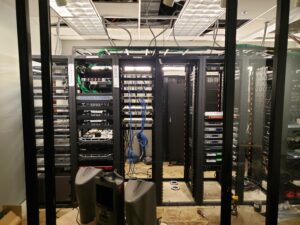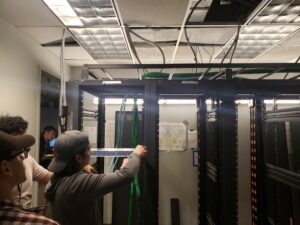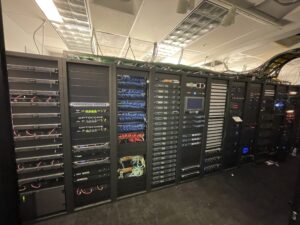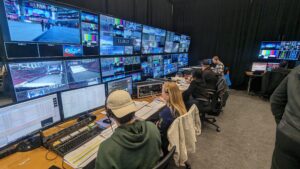Live From Super Bowl LVII: Arizona Cardinals Put New IP-Capable Control Room to the Test on NFL’s Biggest Stage
A complete in-house effort brought the production space to life
Control-room renovations require an extensive amount of time to organize and put together, but, at State Farm Stadium, the Arizona Cardinals did the impossible and finished their most recent project in only two weeks. Spearheaded by Insignia Event Services, the club’s in-venue production and engineering department, the effort completed the switch from an extremely antiquated system to a full-IP facility just in time for Super Bowl LVII.
“We started this turnkey quickly and got it done in two weeks,” says Jesse Janosky, manager, engineering, Insignia Event Services. “It all comes down to how much your ownership trusts you, and, while most executives cringe at the idea of doing this project during this time of year, they’ve been great since the beginning.”
Necessary Move: Equipment Issues, Overall Declines Force the Switch
When Janosky arrived in Glendale, AZ, in November 2021, the signs of aging were apparent in the rack room that had held the production team’s game-day equipment. Engineering teams have to solve a handful of fires on a daily basis, but, prior to the renovation, Janosky went from being a firefighter on a small blaze to having to put out a five-alarm call. In a control room centered on an Evertz EQX router installed a decade ago, equipment began faltering or completely shutting down.
“We started having outputs that were going bad, multiviewers that were dropping, and a lot of elements that were hard to troubleshoot,” he says. “It was so bad that heat sinks were burned off and a lot of cards couldn’t be repaired since they were already at end of life.”

Racks had to be resized to accommodate the new IP equipment.
In the older iteration, the crew had a hodgepodge of equipment that had been installed between 2006 and 2014 — the most recent a full year before the Cardinals hosted Super Bowl XLIX. The original racks were too small to accommodate the cabling and equipment that Janosky’s ideal setup called for. And, when it was necessary to resolve a potentially devastating issue, the behind-the-scenes staff resorted to temporary fixes to problems that called for serious solutions.
“Cables were falling over monitors, so we had to hide them in place with bungee cords,” he says. “We had to strip all of our racks and redo our power. That was done in my first month on the job.”
Local Workforce: Glendale Community College Pitches In
The project was put into motion before Janosky joined the organization last November. Before the most recent NFL season, the franchise realized that something needed to be done with the technology powering control-room operations. The first steps were taken in June 2022, when equipment and gear were purchased and brought into the building.
When Janosky assumed responsibility for the project, his initial goal was to have it completed by the the Cardinals’ home finale in Week 16 on Christmas Day. This target date would have given Senior Director, Game Entertainment and Special Events, Tim Beach and his crew ample time to onboard the equipment and run through potential problems before the Vrbo Fiesta Bowl on New Year’s Eve. Unfortunately, global supply-chain disruptions delayed the arrival of the network switches necessary to make the leap to IP.

Engineering students from Glendale Community College played a big part in the control-room–renovation project.
With the goal of Jan. 1 out the window, Janosky had to get creative to complete the project before Super Bowl LVII. Alongside Chief Engineer Matthew Alvarado and Broadcast Engineers Ian White and Johnathan Wulf, the crew received support and assistance from 21 engineering students at Glendale Community College — which is located less than seven miles from State Farm Stadium. Alvarado, who had joined the crew from Texas A&M, provided the critical experience of working with college students.
“I went to an engineering club and gave a speech, and 11 of them came,” says Janosky. “We ended up going to the school to teach them [how to engineer for in-venue production], and we added 10 more. They love being here to the point where you have to kick them out at night.”
In addition to Alvarado’s collegiate-level experience, Janosky is rolling out his multi-tiered layer of sports-video–production expertise. Having worked with Texas A&M’s 12th Man Productions as director, broadcast technologies, and its transition to an IP control room in 2020, he knows how to navigate the anxieties of the Cardinals’ new system. His tech background includes participating in the NEP mobile-unit apprenticeship program during his first few years in the business. In addition, he spent time with Alpha Video.
“Matt knew how to work the control room and learned how to integrate the systems production,” says Janosky. “I knew how to do the design work from my time at Alpha with cable labels and CAD drawings.”
Agnostic Tech: Various Vendors Supply Gear for Newly Renovated Rack Room
With Janosky’s knowledge leading the way, the team had the luxury of doing something almost completely unheard of: embarking on a massive control-room overhaul without a systems integrator. The full in-house effort may seem daunting, but the decision allowed complete autonomy over the technology integrated into the existing infrastructure.
The new foundation is based on Imagine Communications’ Selenio Network Processor and Cisco’s IP fabric, the same combination used at Texas A&M. Ross Video equipment installed includes an Acuity production switcher and XPression graphics. Riedel provided communications solutions: Artist 1024 intercom, Bolero 1.9-GHz DECT version and the new Bolero 2.4 GHz, 1200 series and 2300 series SmartPanels, and 1000 series panels. TAG Video Systems is being used for stadium monitoring of nearly all SMPTE 2110 feeds, and for this particular game, the company was also tapped for the main technical director mosaics as well as for camera shading and replay operation. Dell 7525 servers are deployed for multiviewing.
In addition, the crew had free rein to work with multiple partners, including systems integrators Alpha and Diversified, technology provider Presidio, and the league-wide partnership for Wi-Fi through CDW.

The Arizona Cardinals’ control-room renovation at State Farm Stadium was completed in time for Super Bowl LVII.
“We’re try to get as close to vendor-agnostic as possible in order to experiment and try what’s best,” says Janosky. “For an engineer, the goal was to focus more on software and scalability versus what one box can do.”
Ultimately, providing as much wiggle room as possible for maneuverability was the result the engineers sought. The roadmap pushed the Cardinals’ production crew to break away from what they knew, get out of their comfort zone, and not permit themselves to resort to old habits. Some adopt this sentiment as a mantra, and, although Janosky and company are wholeheartedly committed to the new workflow, they took an extra step to ensure that they would never take steps backward.
“We put our old router on a furniture dolly and brought it down to an offsite warehouse,” he explains. “We agreed that we’d never leave it [in the control room] because we don’t ever want to turn around and go back [to what used to be].”
Super Challenge: Upcoming Big Game Shortens Timeline
The compressed, two-week framework for rehearsing the in-venue show for Super Bowl LVII necessitated heavy staff reinforcement. Luckily, Janosky has a Rolodex filled with industry contacts. The assembled team comprises former colleague Texas A&M Chief Broadcast Engineer Zack Bacon; Mercedes-Benz Stadium Chief Broadcast and AV Engineer Ben Dolinky, who has a Super Bowl pedigree after 2019’s Super Bowl LIII; and University of Georgia Senior Broadcast Engineer Rick Freeman.
Van Wagner Productions will be the first production crew to test-drive the new infrastructure. Doubts may reasonably creep in, but a longstanding relationship with Janosky assures Van Wagner that the biggest in-venue show of the year will go off with minimal hiccup.

A second control room at State Farm Stadium will put the new production system to the test.
“The stadium’s engineering team had to find the balance of what was the right decision,” says Nate McCoart, director, technical operations, Van Wagner Productions. “They had faith that they could pull it off in the time.”
Janosky’s crew built an additional, basement-level control room to accommodate Van Wagner’s expanded production elements. The new production space will put additional stress on the new system, but it is engineered to supply the canvas for the massive Super Bowl LVII show and subsequent productions.
“It’s on us to make [these new workflows] as seamless as possible,” says Janosky. “We had to get our minds around the fact that there was going to be a B-show control room for the Super Bowl and then see how we can reutilize and integrate this equipment into Cardinals home games.”
Set Up for Success: Cardinals’ Gamble Promises Flexible, Prosperous Future
The new control room’s primary objective is to provide in-stadium entertainment for Arizona Cardinals games and other festivities at State Farm Stadium, but, as the campus grows, the space will be tasked with control of production operations in affiliated buildings. For example, the next two priorities on the list are Heritage at Sportsman’s Park — a private event space located across N 95th Avenue along the Great Lawn — and the adjacent BetMGM Sportsbook.
In years past, such an endeavor would force Janosky to either buy separate equipment reserved for these venues or lug equipment from the State Farm Stadium control room to either building. After the $3 million renovation, the control room is a centralized production hub with exterior connectivity to each location and also has breathing room for changes in the short term.
“You can stay relevant [with technology] only if you have a plan for a refresh that’s attainable,” Janosky says. “If you’re going to wait seven years and fix it all, you’re going to pigeonhole yourself by having to do that every seven years. It’s more attainable if you have a two- or three-year plan.”
With the control-room revamp as the No. 1 item on his list, followed by refining workflow for the 5½-month-old main LED videoboard, Janosky has gone full throttle in his first three months. It has been a taxing time span, but, if it enhances the Cardinals’ production effort, it’s an extremely rewarding project.
“This will definitely impact our fan experience in a positive way,” says Janosky. “We’ve set ourselves up nicely moving forward.”
